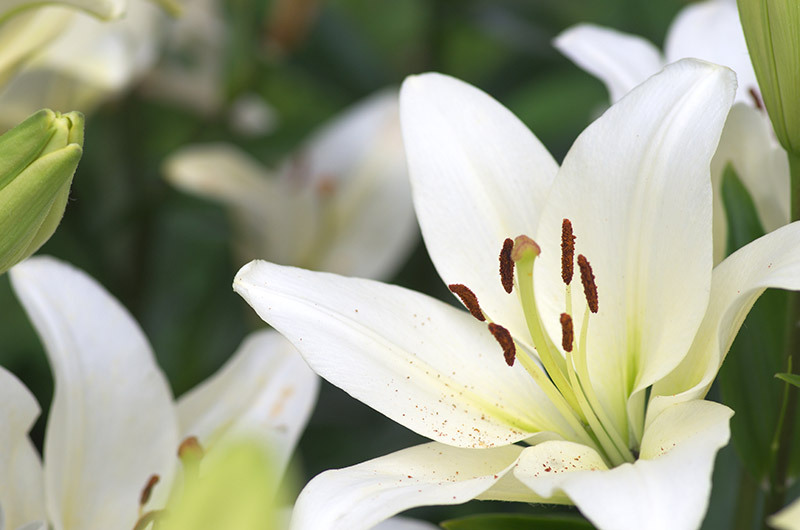Simple Steps for Effective Orchid Care
Posted on 04/09/2025
Simple Steps for Effective Orchid Care
Orchids are among the most captivating and elegant houseplants, admired for their stunning blooms and fascinating structures. While many consider these exotic plants high-maintenance, proper orchid care is easier than you might think. With the right guidance, you can grow healthy, thriving orchids that flower year after year. In this comprehensive guide, we provide simple steps for effective orchid care designed for beginners and seasoned enthusiasts alike.

Understanding Orchids: The Basics
Before diving into specific care instructions, it's important to understand a bit about the nature of orchids. The orchid family (Orchidaceae) is the largest plant family in the world, boasting more than 25,000 species. Most popular home orchids, such as Phalaenopsis (Moth Orchid), Cattleya, Dendrobium, and Oncidium, are epiphytes. This means they naturally grow on trees, with their roots exposed to air and rainfall rather than being buried in soil.
Recognizing this crucial detail helps to inform every aspect of proper orchid care--from soil and water to light and humidity. Now, let's break down the best orchid care practices into simple, actionable steps.
Step 1: Choose the Right Orchid Variety
Your journey to successful orchid care starts with choosing a variety that matches your home environment and experience level. For beginners, Phalaenopsis or Moth Orchids are an excellent choice. They're widely available, adaptable, and reward growers with long-lasting blooms. More advanced growers might enjoy experimenting with Cattleya or Dendrobium species.
Popular Orchid Varieties for Home Growing
- Phalaenopsis (Moth Orchids): Easy-care, blooms up to three months, low light tolerant.
- Cattleya Orchids: Known for large, fragrant flowers, require brighter light.
- Dendrobium Orchids: Compact and floriferous, come in many colors and shapes.
- Oncidium (Dancing Lady): Prefers bright, indirect light, produces many small flowers.
Step 2: Provide Proper Lighting
One of the keys to effective orchid care is ensuring your plant receives the optimum amount of light. Orchids need bright, indirect light to thrive--direct sunlight can scorch their delicate leaves, while too little light prevents blooming.
Lighting Tips for Healthy Orchids
- East-facing windows offer gentle morning light that is ideal for many orchid types, especially Phalaenopsis.
- South or west-facing rooms should be filtered with sheer curtains to prevent leaf burn.
- Watch for leaf color clues: Medium green leaves signal good lighting, while dark green suggests not enough light and yellowish tones mean too much sunlight.
- If natural light is insufficient, supplement with grow lights, placed 6-12 inches above the foliage.
Step 3: Master Orchid Watering Techniques
Improper watering is the leading cause of orchid problems. Orchids hate "wet feet"; overwatering can quickly kill your plant by suffocating the roots and causing rot. Learning the right way to water orchids is crucial for long-term success.
Best Practices for Watering Orchids
- Water only when the potting medium is nearly dry. Stick your finger about an inch into the medium to test.
- Use room temperature, non-softened water--rainwater or distilled water is best.
- Thoroughly drench the roots and allow all excess water to drain away. Never leave your orchid sitting in standing water.
- Frequency varies--typically, Phalaenopsis orchids need watering about once a week, less often in winter.
- Consider the humidity, temperature, and light: warmer, drier conditions require more frequent watering.
Tip: Water your orchid in the morning so the foliage dries by nightfall, reducing risk of disease.
Step 4: Use the Right Orchid Potting Mix
Remember, orchids are not potted in regular soil. Their roots require excellent aeration. An effective orchid potting mix typically contains ingredients like:
- Pine bark or fir bark
- Sphagnum moss
- Coconut husk
- Perlite or charcoal
The mix you choose depends on orchid variety and your home's humidity. Loose, chunky mixes drain quickly and ensure the roots get plenty of air--a must for healthy orchid growth.
Repotting Orchids:
- Repot your orchid every 1-2 years or when the medium breaks down.
- Remove dead roots and old media during repotting.
- Choose a pot with good drainage--transparent pots allow you to monitor root health and moisture.
Step 5: Maintain Ideal Humidity and Air Circulation
Orchids naturally thrive in higher humidity environments. Aim for 40-60% humidity in your home for best orchid care. If your air is very dry, increase humidity with the following methods:
- Place your orchid pot on a shallow humidity tray (a shallow dish with pebbles and water beneath the pot, not touching the roots).
- Mist your orchids lightly in the morning (avoid letting water sit in the crown of the leaves).
- Use a small room humidifier nearby.
Also, good air circulation is essential. Orchids dislike stagnant, moist air as it encourages fungal and bacterial diseases. A small oscillating fan nearby (not directly on the orchids) can help keep air moving gently.
Step 6: Fertilize for Healthy Growth and Beautiful Flowers
Orchids need nutrition to produce vivid blooms and new leaves. Use a balanced, water-soluble fertilizer specifically designed for orchids. The common mantra is "weakly, weekly": fertilize with a diluted solution every two to four weeks when your orchid is actively growing. Reduce feeding in winter or during dormant periods.
Orchid Fertilizing Guidelines
- Choose a fertilizer with equal parts nitrogen (N), phosphorus (P), and potassium (K), such as 20-20-20.
- Dilute fertilizer to 1/4 or 1/2 the recommended strength to avoid root burn.
- Flush the potting medium with clear water monthly to remove salt buildup from fertilizers.
Step 7: Encourage Re-Blooming
One of the most rewarding parts of orchid cultivation is encouraging your plant to bloom year after year. If your orchid isn't re-blooming, don't despair-- a few adjustments can jump-start new flower spikes.
How to Trigger Orchid Blooming
- Provide a drop in nighttime temperatures (ideally 55-65?F / 13-18?C) during the fall. This simulates natural seasonal changes.
- Maintain consistent lighting during shorter autumn days--supplement with artificial light if necessary.
- After flowers fade, trim the spent spike just above a visible node to encourage a branching flower stem--especially for Phalaenopsis orchids.
Patience is key--many orchids take several months between flower cycles. Continue proper orchid care techniques and your plant will eventually reward you with stunning new blooms.
Step 8: Monitor for Pests and Diseases
With correct habits, most orchid issues can be prevented. Still, it's important to check your plants regularly for signs of trouble. Early detection makes treatment easier and keeps your collection healthy.
Common Orchid Problems
- Yellowing leaves: Often due to overwatering or inadequate light.
- Pseudobulbs that shrivel: Underwatering or root problems.
- Sticky residue or cottony masses: Indicates scale or mealybug infestation.
- Black or mushy spots on leaves: Bacterial or fungal disease. Remove affected parts and increase air circulation.
Treat pests promptly with insecticidal soap or neem oil. For diseases, remove and discard affected tissues and sterilize your cutting tools between uses.
Step 9: Seasonal Orchid Care Tips
Orchid care changes slightly with the seasons:
- Spring: Ideal time for repotting and fertilizing as new growth emerges.
- Summer: Increase watering frequency and monitor humidity. Protect from direct midday sun.
- Autumn: Reduce watering as temperatures drop. Trigger blooming with cooler nights.
- Winter: Reduce fertilization, keep orchids warm, and guard against cold drafts and dry air.

Step 10: Frequently Asked Questions About Orchid Care
How often should I water my orchid?
Watering frequency depends on orchid type and home conditions, but most orchids prefer to dry out slightly between waterings. As a general guide, water once every 7-10 days for Phalaenopsis and every 5-7 days for thinner-leaved varieties. Always check the potting mix before watering.
Can orchids grow in regular potting soil?
No. Orchids require a special chunky potting medium--regular soil holds too much moisture and suffocates roots. Always use an orchid mix containing bark, moss, perlite, or coconut husk.
Why are my orchid's leaves turning yellow?
Yellow leaves are often a sign of overwatering, poor drainage, or insufficient light. Check your orchid care routine and adjust as necessary.
How do I make my orchid bloom again?
Most orchids need cooler night temperatures and consistent care to flower again. Make sure you're providing enough light, the right temperature drop at night, and careful feeding during active growth.
Conclusion: Enjoy the Beauty of Orchids With These Care Steps
With these simple steps for effective orchid care, even first-time growers can achieve spectacular results. Remember, every orchid is a little different--observation, patience, and small adjustments are key. Choose the right orchid, provide proper light and humidity, master watering, and your plant will thrive, rewarding you with years of elegant blooms.
If you're new to orchids, start with one plant and gradually expand your collection. The experience of nurturing these unique flowers is endlessly rewarding. Follow this guide and you'll enjoy healthy, flowering orchids that brighten your home and impress visitors for years to come.
Happy orchid growing!
Latest Posts
Simple Steps for Effective Orchid Care
Hydrangea harmony: achieve garden bliss with care
Sunflower Wonders: 8 Facts That Will Captivate You






